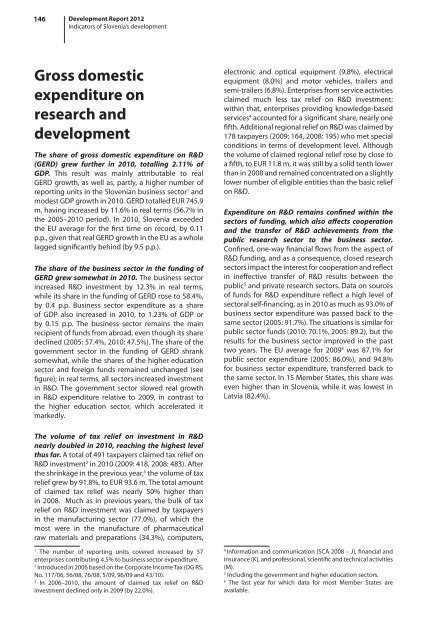development report 2012 - UMAR
development report 2012 - UMAR
development report 2012 - UMAR
Create successful ePaper yourself
Turn your PDF publications into a flip-book with our unique Google optimized e-Paper software.
146 Development Report <strong>2012</strong><br />
Indicators of Slovenia’s <strong>development</strong><br />
Gross domestic<br />
expenditure on<br />
research and<br />
<strong>development</strong><br />
The share of gross domestic expenditure on R&D<br />
(GERD) grew further in 2010, totalling 2.11% of<br />
GDP. This result was mainly attributable to real<br />
GERD growth, as well as, partly, a higher number of<br />
<strong>report</strong>ing units in the Slovenian business sector 1 and<br />
modest GDP growth in 2010. GERD totalled EUR 745.9<br />
m, having increased by 11.6% in real terms (56.7% in<br />
the 2005–2010 period). In 2010, Slovenia exceeded<br />
the EU average for the first time on record, by 0.11<br />
p.p., given that real GERD growth in the EU as a whole<br />
lagged significantly behind (by 9.5 p.p.).<br />
The share of the business sector in the funding of<br />
GERD grew somewhat in 2010. The business sector<br />
increased R&D investment by 12.3% in real terms,<br />
while its share in the funding of GERD rose to 58.4%,<br />
by 0.4 p.p. Business sector expenditure as a share<br />
of GDP also increased in 2010, to 1.23% of GDP or<br />
by 0.15 p.p. The business sector remains the main<br />
recipient of funds from abroad, even though its share<br />
declined (2005: 57.4%, 2010: 47.5%). The share of the<br />
government sector in the funding of GERD shrank<br />
somewhat, while the shares of the higher education<br />
sector and foreign funds remained unchanged (see<br />
figure); in real terms, all sectors increased investment<br />
in R&D. The government sector slowed real growth<br />
in R&D expenditure relative to 2009, in contrast to<br />
the higher education sector, which accelerated it<br />
markedly.<br />
electronic and optical equipment (9.8%), electrical<br />
equipment (8.0%) and motor vehicles, trailers and<br />
semi-trailers (6.8%). Enterprises from service activities<br />
claimed much less tax relief on R&D investment;<br />
within that, enterprises providing knowledge-based<br />
services 4 accounted for a significant share, nearly one<br />
fifth. Additional regional relief on R&D was claimed by<br />
178 taxpayers (2009: 164, 2008: 195) who met special<br />
conditions in terms of <strong>development</strong> level. Although<br />
the volume of claimed regional relief rose by close to<br />
a fifth, to EUR 11.8 m, it was still by a solid tenth lower<br />
than in 2008 and remained concentrated on a slightly<br />
lower number of eligible entities than the basic relief<br />
on R&D.<br />
Expenditure on R&D remains confined within the<br />
sectors of funding, which also affects cooperation<br />
and the transfer of R&D achievements from the<br />
public research sector to the business sector.<br />
Confined, one-way financial flows from the aspect of<br />
R&D funding, and as a consequence, closed research<br />
sectors impact the interest for cooperation and reflect<br />
in ineffective transfer of R&D results between the<br />
public 5 and private research sectors. Data on sources<br />
of funds for R&D expenditure reflect a high level of<br />
sectoral self-financing, as in 2010 as much as 93.0% of<br />
business sector expenditure was passed back to the<br />
same sector (2005: 91.7%). The situations is similar for<br />
public sector funds (2010: 70.1%, 2005: 89.2), but the<br />
results for the business sector improved in the past<br />
two years. The EU average for 2009 6 was 87.1% for<br />
public sector expenditure (2005: 86.0%), and 94.8%<br />
for business sector expenditure, transferred back to<br />
the same sector. In 15 Member States, this share was<br />
even higher than in Slovenia, while it was lowest in<br />
Latvia (82.4%).<br />
The volume of tax relief on investment in R&D<br />
nearly doubled in 2010, reaching the highest level<br />
thus far. A total of 491 taxpayers claimed tax relief on<br />
R&D investment 2 in 2010 (2009: 418, 2008: 483). After<br />
the shrinkage in the previous year, 3 the volume of tax<br />
relief grew by 91.8%, to EUR 93.6 m. The total amount<br />
of claimed tax relief was nearly 50% higher than<br />
in 2008. Much as in previous years, the bulk of tax<br />
relief on R&D investment was claimed by taxpayers<br />
in the manufacturing sector (77.0%), of which the<br />
most were in the manufacture of pharmaceutical<br />
raw materials and preparations (34.3%), computers,<br />
1<br />
The number of <strong>report</strong>ing units covered increased by 57<br />
enterprises contributing 4.5% to business sector expenditure.<br />
2<br />
Introduced in 2006 based on the Corporate Income Tax (OG RS,<br />
No. 117/06, 56/08, 76/08, 5/09, 96/09 and 43/10).<br />
3<br />
In 2006–2010, the amount of claimed tax relief on R&D<br />
investment declined only in 2009 (by 22.0%).<br />
4<br />
Information and communication (SCA 2008 – J), financial and<br />
insurance (K), and professional, scientific and technical activities<br />
(M).<br />
5<br />
Including the government and higher education sectors.<br />
6<br />
The last year for which data for most Member States are<br />
available.
















